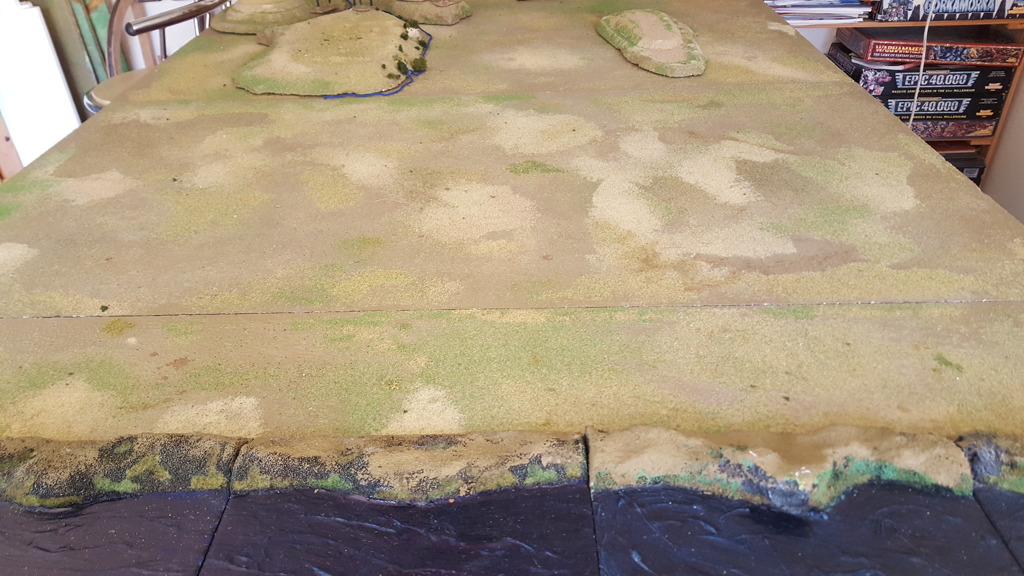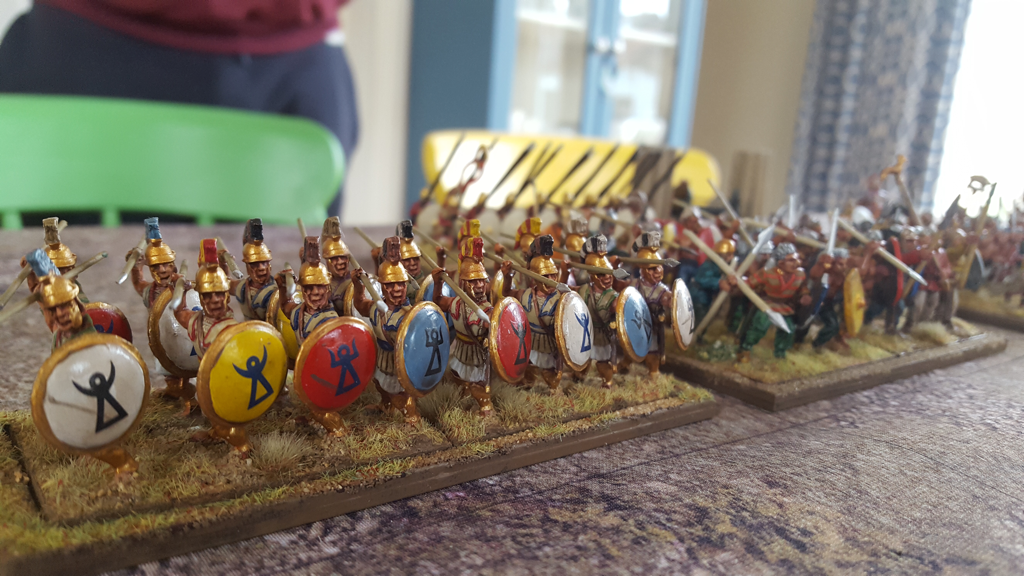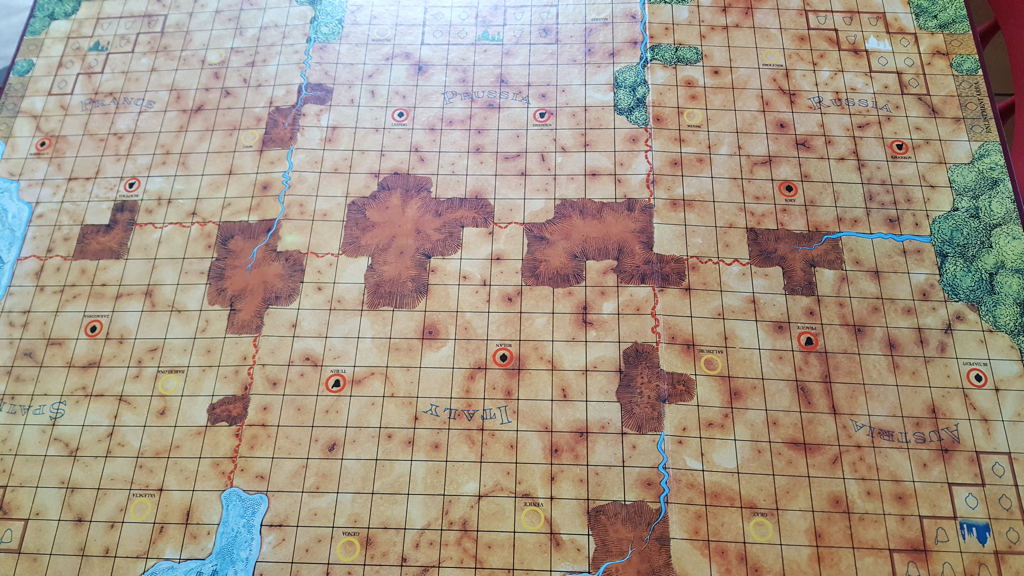|
Gaming the Metaurus My previous blog post explained how we created an ADLG scenario for the battle of the Metaurus. This post tells you how the game went. Ben took the role of Hamilcar and Matt commanded the Romans. Ben followed Hamilcar’s deployment, putting his Gauls on the high ground protected by a strip of difficult terrain. He put his elephants in the centre, with Spanish and African foot behind them, and his cavalry on the right, supported by two more stands of Spanish foot. Matt deployed one infantry command on his left, the other in the centre and his cavalry on his right. Phase one of the game saw Ben’s elephants crash into Matt ‘s centre and pretty much slide off. We had expected them to be destroyed while disrupting the Roman centre but they barely made a dent. Matt’s dice rolling was consistently luckier than Ben’s, setting the pattern for the evening. On the Carthaginian left the Gauls and Roman cavalry looked at each other, while by the river, Ben’s cavalry advanced on Matt’s infantry but wisely chose not to attack. In Phase two the two centres came to blows. Ben’s troops fought rather better than their elephants had done and the fight was quite balanced. Meanwhile a couple of stands of Gauls came off the high ground, to be mauled by Matt’s cavalry. Then, Ben decided to launch his cavalry at Matt’s unruffled left wing. Matt again rolled some lucky dice but he also had the edge in modifiers all along this combat. Ben lost several stands in one combat phase, taking him perilously close to break point. In the final phase the rest of Ben’s Gauls came down from the high ground, too late to have an effect on the battle. His cavalry nearly all routed and his centre started to crumble, mainly because his Spanish MI were less resilient. The game then ended as Ben’s morale losses hit 26. At that point Matt’s losses were only 9 points, of which only 4 were due to units routing. Measuring up to the history
According to the generally accepted account of the battle the Carthaginians deployed pretty much as Ben did in our game. The Romans on the other hand placed their cavalry by the river, Salinator in the centre and Nero on the right. Phase one of the battle saw the Carthaginian elephants attacking in the centre, with similar unimpressive results to what happened in the game. On the left the cavalry wings clashed and the Romans began to push the Carthaginians back. The infantry in the centre then closed, with neither side gaining the advantage. On the right Nero soon abandoned any intention to charge the Gauls, who were too well positioned on the high ground. He then marched his wing around the rear of the Roman line to the left and assaulted the Carthaginian centre in its right flank. With this, Hamilcar’s army collapsed and he spurred his horse into the melee. The first Hannibal knew of the defeat was when his brother’s severed head was catapulted into his camp. The big difference in our game was of course Matt ‘s deployment of infantry on his left and cavalry on the right. This made Nero’s manoeuvre impossible. I could, I guess, have imposed historical deployment on both sides but would argue that the more restrictive the setup, the less satisfying the game. To be frank, I was surprised by Matt ‘s deployment and wondered at the outset if he was squandering his cavalry by placing it facing the Gallic Hill. As things turned out, I couldn’t argue with his emphatic victory so what do I know? Nevertheless his cavalry played only a bit part in that victory. I think he was helped by Ben’s decision to charge Roman heavy swordsmen with medium cavalry, rather perhaps than to shift this cavalry to face the Roman horse. In the last turn Ben had to take a survival roll for his C in C when the unit he was with routed. He passed it, so at least our Hamilcar kept his head
0 Comments
We played a 200 Point game of ADLG last night. I always enjoy a game more if it is linked to a real battle (however fuzzily) and I wanted to see if I could fit a historical scenario into a ‘legal’ ADLG format. I chose the Battle of the Metaurus, 207BC, fought between Hamilcar Barca and a consular tag team of Salinator and Nero. This post is about turning a historical battle into a scenario. The next one will report how the game played. Background The Metaurus campaign was perhaps the last chance for Carthage to defeat Rome in Italy. After years of stalemate on the peninsular, Hamilcar had crossed the Alps with an army to reinforce Hannibal. Rome was determined to prevent the Barca brothers from joining forces and a lucky piece of intelligence revealed Hamilcar’s planned route. Nero, commanding the consular army facing Hannibal, took a picked force and rushed to join his colleague Salinator in front of Hamilcar. From being outnumbered, the Romans now had at least parity with Hamilcar and for once, seemed to have an advantage in cavalry. The Romans tried to hide the arrival of Nero and bring on a battle but Hamilcar realised that he was facing two consuls, supposedly because his scouts heard two trumpet calls in the Roman camp. Hamilcar withdrew along the river Metaurus, looking for a crossing point. However he was unable to cross and as the Roman pursuers came closer, he resolved to offer battle. There are different versions of this story in the sources and the debate goes on about the location of the battle, nature of the field and forces involved. I chose what seems to be the current majority view, which results in the following elements: Because he has turned to face his pursuers, Hamilcar deploys his whole army first. The river Metaurus runs down one flank of the table. It is impassable. Hamilcar deploys with his right wing on the river. Next to the river is a strip of open ground. Hamilcar’s left deploys on high ground, with a steep defile in front that will seriously disadvantage an attacker. The Roman side of the field has a low hill towards the rear, opposite the high ground. Otherwise it is featureless. After Hamilcar has deployed, the Romans deploy using the standard deployment rules, except that there is no ‘dead zone’ next to the river so troops may deploy adjacent to it. The Armies
I created two 200 Point ADLG armies, using army lists 53 and 55. All troop types were picked straight from the lists except the Gallic foot. Hamilcar’s Gauls were recently recruited. Some stories say they were drunk at the battle but it is also possible that they were just disaffected and shaky. Either way they fought badly and Hamilcar deployed them on the high ground to make the best of a poor contingent. I decided they would be mediocre heavy swordsmen and not impetuous, reducing their points cost accordingly. Hamilcar’s army contained 6 stands of the mediocre Gallic Heavy swordsmen; 4 of Spanish medium swordsmen; 2 of African spearmen; 2 of Spanish medium cavalry; 3 of Gallic medium cavalry; 3 elephants; 3 Libyan light infantry with javelins; and 3 of slingers. Hamilcar was brilliant and his two subordinates were competent. Break point 26. Nero and Salinator commanded 10 stands of hastati/princeps heavy swordsmen; 5 of light infantry velites; 2 of Allied light infantry; 2 of triarii elite heavy spearmen; 4 of Roman medium cavalry and 2 of Allied heavy cavalry. Nero was brilliant and Salinator and Licinius were competent. Break point 25. Ben and Matt faced off on Wednesday evening. Their exploits are reported in my next post. There is a charity bookshop in our High Street, run by the Woking Hospice, that carries a particularly good history section. I have picked up some great books there over the years. Recently they started selling second hand games as well. This week I picked up Waddington’s Campaign, in excellent condition but for a slightly tatty box. I had no choice: my memory made me do it. As a teenager I loved this game. It came out in 1971 and I was given a copy soon after. It was a good time for a newcomer to Napoleon, thanks to the film Waterloo, Airfix’s range of Waterloo figures and Bruce Quarrie’s Napoleonic Wargame rules. Waddingtons gave the game a Napoleonic flavour, suggesting players could refight the conquest of Europe. In fact the game is pretty abstract and could as easily have been linked to another period. It is a great game nevertheless. Each player begins in their capital with an army of infantry and cavalry pieces plus a general. Their aim is to capture cities (some of which are recruitment centres), defeat the enemy’s armies and occupy their capital. The mechanisms borrow a little from chess and a bit from Diplomacy. In order to remove an enemy piece a player must neutralise all adjacent enemy pieces and still have two pieces attacking the target. No dice are involved. Clever deployment can block invasion routes and make it very hard for the enemy to pick off your pieces.
I suppose I should persuade somebody to play it with me to see whether it is as fun to play as I remember. But to be honest, just owning the game again after a break of 40 odd years is pleasure enough. |
Archives
November 2023
Categories
All
|










 RSS Feed
RSS Feed